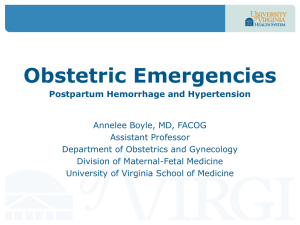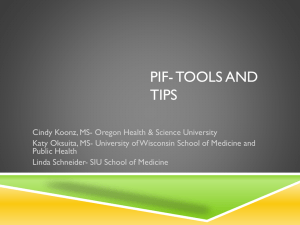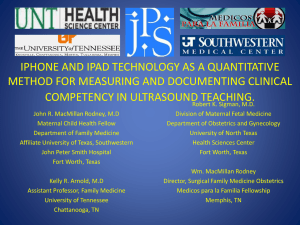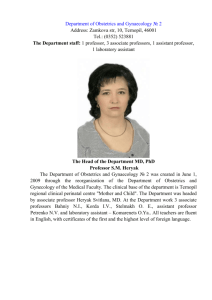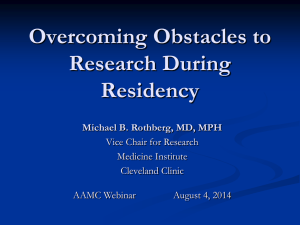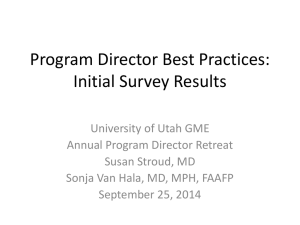Obstetrics and Gynecology
advertisement
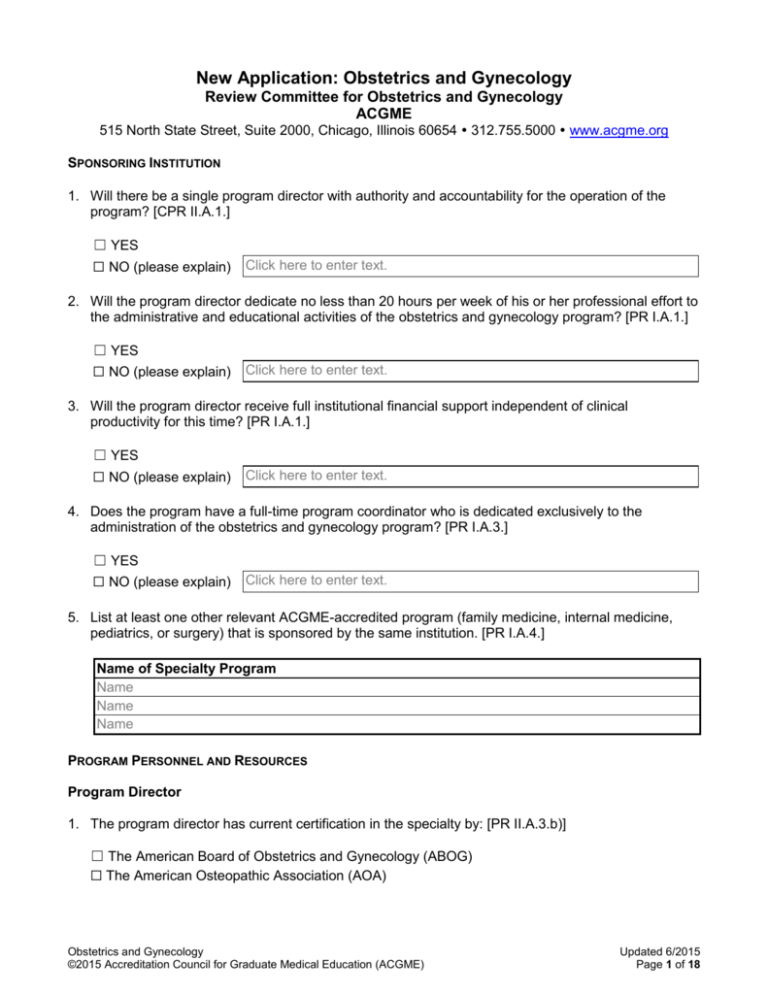
New Application: Obstetrics and Gynecology
Review Committee for Obstetrics and Gynecology
ACGME
515 North State Street, Suite 2000, Chicago, Illinois 60654 312.755.5000 www.acgme.org
SPONSORING INSTITUTION
1. Will there be a single program director with authority and accountability for the operation of the
program? [CPR II.A.1.]
☐ YES
☐ NO (please explain)
Click here to enter text.
2. Will the program director dedicate no less than 20 hours per week of his or her professional effort to
the administrative and educational activities of the obstetrics and gynecology program? [PR I.A.1.]
☐ YES
☐ NO (please explain)
Click here to enter text.
3. Will the program director receive full institutional financial support independent of clinical
productivity for this time? [PR I.A.1.]
☐ YES
☐ NO (please explain)
Click here to enter text.
4. Does the program have a full-time program coordinator who is dedicated exclusively to the
administration of the obstetrics and gynecology program? [PR I.A.3.]
☐ YES
☐ NO (please explain)
Click here to enter text.
5. List at least one other relevant ACGME-accredited program (family medicine, internal medicine,
pediatrics, or surgery) that is sponsored by the same institution. [PR I.A.4.]
Name of Specialty Program
Name
Name
Name
PROGRAM PERSONNEL AND RESOURCES
Program Director
1. The program director has current certification in the specialty by: [PR II.A.3.b)]
☐ The American Board of Obstetrics and Gynecology (ABOG)
☐ The American Osteopathic Association (AOA)
Obstetrics and Gynecology
©2015 Accreditation Council for Graduate Medical Education (ACGME)
Updated 6/2015
Page 1 of 18
2. Has it been at least five years since the program director completed residency?
[PR II.A.3.d)]
☐ YES
☐ NO (please explain)
Click here to enter text.
3. Does the program director have current medical licensure in the state in which the program is
located? [CPR II.A.3.c)]
☐ YES
☐ NO (please explain)
Click here to enter text.
4. Does the program director hold an appointment at the sponsoring institution or at a major
participating site? [CPR II.A.3.c)]
☐ YES
☐ NO (please explain)
Click here to enter text.
5. Describe the program director’s educational and administrative experience that ensures that she or
he has the requisite expertise to hold the position of residency program director. (List at least five
but no more than ten examples in the last five years.) [CPR II.A.3.a)]
Click here to enter text.
6. Describe the program director’s clinical experience within the specialty that ensures that he or she
has the requisite expertise to hold the position of residency program director? (List at least three but
no more than five examples in the last five years.) [PR II.A.3.a)]
Click here to enter text.
7. Describe the program director’s role in the selection of program faculty. [CPR II.A.4.c)]
Click here to enter text.
8. How will the program director ensure the quality of resident education at each site that participates
in the program? [CPR II.A.4.a)]
Click here to enter text.
9. How will the program director evaluate and provide feedback to the faculty based on this
evaluation? [CPR II.A.4.d)]
Click here to enter text.
Faculty
1. How will the program ensure that there is a faculty-led environment of inquiry and scholarship with
an active research component? Limit response to 200 words. [CPR II.B.5.]
Click here to enter text.
Obstetrics and Gynecology
©2015 Accreditation Council for Graduate Medical Education (ACGME)
Updated 6/2015
Page 2 of 18
2. Will the faculty be available to a resident in the OR, Labor and Delivery, and resident clinics if
clinical activity is taking place? [PR II.B.6.]
☐ YES
☐ NO (please explain)
Click here to enter text.
3. Please list the individuals who will serve as Subspecialty Faculty Educators in each of the following
subspecialties of obstetrics and gynecology, and briefly outline their qualifications to serve in this
capacity. Limit response to 50 words per educator. {PR II.B.8.}
a) Female Pelvic Medicine and Reconstructive Surgery
Click here to enter text.
b) Gynecologic Oncology
Click here to enter text.
c) Maternal-fetal Medicine
Click here to enter text.
d) Reproductive Endocrinology and Infertility
Click here to enter text.
Resources
1. Facilities
Briefly describe how the program will ensure that medical, radiologic, and laboratory data retrieval
capabilities will be accessible from all outpatient and inpatient facilities to enable efficient and
effective patient care. [PR II.D.1.]
Click here to enter text.
2. Resident Facilities and Support Services
Will the following facilities be available for the program? [PR II.D.2.-5.] Please explain any “no”
answers.
Laboratory and radiologic services .......................................................................... ☐ YES ☐ NO
Intravenous (IV) services ......................................................................................... ☐ YES ☐ NO
Phlebotomy services ............................................................................................... ☐ YES ☐ NO
Messenger/transporter services in sufficient number to meet reasonable demands at all times
................................................................................................................................ ☐ YES ☐ NO
e) Meeting rooms and classrooms with audiovisual and other educational aids, simulation
capabilities, and office space for staff members ...................................................... ☐ YES ☐ NO
f) Adequate inpatient and outpatient facilities, and office space accessible to residents
................................................................................................................................ ☐ YES ☐ NO
g) Safe, quiet, private sleep facilities for residents in close proximity to where obstetrics and
gynecology patient care is rendered ....................................................................... ☐ YES ☐ NO
a)
b)
c)
d)
Click here to enter text.
Obstetrics and Gynecology
©2015 Accreditation Council for Graduate Medical Education (ACGME)
Updated 6/2015
Page 3 of 18
3. Obstetrics – Profile of Program
Enter the total number of procedures for the most recent academic year for each proposed site
listed in ADS. [PR II.D.6.]
Spontaneous deliveries
Cesarean deliveries
Operative vaginal deliveries
Obstetric ultrasound
Percent of obstetric patients
available for resident
education
Site #1
#
#
#
#
Site #2
#
#
#
#
Site #3
#
#
#
#
Site #4
#
#
#
#
Site #5
#
#
#
#
Total
#
#
#
#
#%
#%
#%
#%
#%
#%
4. Gynecology – Profile of Program
Enter the total number of procedures (inpatient and outpatient) for the most recent academic year
for each proposed site listed in ADS. [PR II.D.6.]
Abdominal hysterectomy
Vaginal hysterectomy
Laparoscopic hysterectomy all types, including robotic
Surgery for urinary
incontinence (vaginal or
abdominal) and
reconstructive pelvic
procedures
Operative laparoscopic
procedures
Cystoscopy
Operative hysteroscopy
Abortion
Transvaginal ultrasound
Surgery for invasive cancer
Percent of gynecologic
surgery patients available for
resident education
Site #1
#
#
Site #2
#
#
Site #3
#
#
Site #4
#
#
Site #5
#
#
Total
#
#
#
#
#
#
#
#
#
#
#
#
#
#
#
#
#
#
#
#
#
#
#
#
#
#
#
#
#
#
#
#
#
#
#
#
#
#
#
#
#
#
#
#
#
#
#
#
#
#
#%
#%
#%
#%
#%
#%
APPOINTMENT OF FELLOWS AND OTHER LEARNERS
1. For the most recent academic year, list the total number of fellows (in accredited and nonaccredited fellowships) who receive any training in this program for each participating site listed in
ADS, as well as the duration of training. Insert additional rows as needed. [CPR III.D.]
Subspecialty
Number Currently
Enrolled
Obstetrics and Gynecology
©2015 Accreditation Council for Graduate Medical Education (ACGME)
Site #
Duration of Training
Updated 6/2015
Page 4 of 18
Subspecialty
Number Currently
Enrolled
Site #
Duration of Training
2. Other Learners Receiving Education in this Program
Provide the categories of learners, number of learners, level of education, rotation or service, length
of assignment, and site #. Insert additional rows as needed. [CPR III.D.]
Category of
Learners
Number of
Learners
Level of
Education
Rotation or
Service
Length of
Site #
Assignment (as listed in
per Individual
ADS)
EDUCATIONAL PROGRAM
Regularly Scheduled Didactic Sessions
1. List all regularly scheduled educational activities of this program. These sessions should consist of
teaching rounds, case conferences, simulation training, journal clubs, and protected time for
educational activities covering all aspects of obstetrics and gynecology. Designate whether the
activity is required (R), optional (O), or required of residents only when they are on that particular
service (RS) and the frequency. List them in the order of R, then RS, then O. Insert additional
rows as needed. [CPR IV.A.3.]
Name of Activity
R/RS/O
Obstetrics and Gynecology
©2015 Accreditation Council for Graduate Medical Education (ACGME)
Frequency Per Month
Updated 6/2015
Page 5 of 18
Name of Activity
R/RS/O
Frequency Per Month
2. Describe the program’s interdisciplinary educational activities and who, in addition to the residents,
participates. [PR IV.A.3.c]
Click here to enter text.
Patient Care
1. Briefly describe how the program will provide an experience, closely supervised by faculty
members, that ensures continuity of patient care by an individual resident. [PR IV.A.5.a).(1)] (Limit
response to 200 words)
Click here to enter text.
2. Describe how residents will be given increasing responsibility under the supervision of a qualified,
on-site, attending staff/faculty member? [PR IV.A.5.a).(1).(b)] (Limit response to 200 words)
Click here to enter text.
3.
Continuity Clinic
a) Describe the continuity clinic experience in detail, including: (Limit each response to 100 words)
[PR IV.A.6.b)]
(1) organizational structure (location, number of sites, patient scheduling, etc.)
Click here to enter text.
(2) qualifications of faculty member(s) responsible for supervision
Click here to enter text.
(3) residents’ responsibility for follow-up of their continuity patients’ problems, results of lab
tests, imaging studies, or consultations that may occur between visits
Click here to enter text.
Obstetrics and Gynecology
©2015 Accreditation Council for Graduate Medical Education (ACGME)
Updated 6/2015
Page 6 of 18
b) Describe how residents will receive faculty member guidance for developing an action plan to
improve patient care outcomes based on their performance data, and evaluation of this plan at
least twice per year (Limit response to 100 words) [PR IV.A.6.b).(4).(b)]
Click here to enter text.
c) Continuity Clinic Data (Do not include sessions that are obstetric only)
PGY-1
PGY-2
PGY-3
PGY-4
Planned number of weeks Planned number of halfEstimated average
of clinic per year per
day sessions per resident number of patients seen
resident
per week
per resident per session
#
#
#
#
#
#
#
#
#
#
#
#
4. Briefly describe the settings and activities in which residents will develop and ultimately
demonstrate the ability to serve as the primary physician of women. [PR IV.A.5.a).(1).(a)] (Limit
response to 400 words)
Click here to enter text.
5. Briefly describe the settings and activities in which residents will develop and ultimately
demonstrate the ability to manage patients in a variety of health care settings. [PR IV.A.5.a).(1).(c)]
(Limit response to 400 words)
Click here to enter text.
6. Briefly describe how the program will provide objective assessments of competence on the
specialty-specific Milestones in patient care and procedural skills, medical knowledge, practicebased learning and improvement, interpersonal and communication skills, professionalism, and
systems-based practice. [PR V.A.2.b).(1)] (Limit response to 400 words)
Click here to enter text.
7. Briefly describe how the program will ensure that residents, upon completion of training, will be able
to manage patients in the medical and surgical care of the female reproductive system and
associated disorders and act as the primary physician of women. [IV.A.5.a).(1).(a)] (Limit response
to 400 words)
Click here to enter text.
Core Competencies
Describe how the program ensures that residents acquire knowledge of the core and subspecialty
content of obstetrics and gynecology appropriate for the unsupervised practice of obstetrics and
gynecology. [PR IV.A.5.b).(1)]
1. Primary and Preventive Ambulatory Health Care
Obstetrics and Gynecology
©2015 Accreditation Council for Graduate Medical Education (ACGME)
Updated 6/2015
Page 7 of 18
A.
B.
C.
D.
Competency Area
Periodic health assessments and
immunizations
Preventive health care, including obesity
counseling, smoking cessation, exercise,
safety, domestic violence
Focused areas of gynecologic care
1. Contraception
2. Induced abortion
3. Sexual/lesbian/transgender health
4. Sexual dysfunction
5. Menstrual disorders
Management of non-gynecologic conditions
1. Abdominal pain
2. Allergic rhinitis
3. Arthritis
4. Asthma
5. Common gastrointestinal/urinary
disorders
6. Diabetes mellitus
7. Depression/anxiety
8. Headache
9. Hypertension
10. Lipid disorders
11. Low back pain
12. Osteoporosis
13. Overweight/obesity
14. Skin disorders
15. Thyroid diseases
Settings/Activities
Click here to enter text.
Click here to enter text.
Click here to enter text.
Click here to enter text.
Click here to enter text.
Click here to enter text.
Click here to enter text.
Click here to enter text.
Click here to enter text.
Click here to enter text.
Click here to enter text.
Click here to enter text.
Click here to enter text.
Click here to enter text.
Click here to enter text.
Click here to enter text.
Click here to enter text.
Click here to enter text.
Click here to enter text.
Click here to enter text.
Click here to enter text.
Click here to enter text.
2. Obstetrics
Competency Area
A. Basic science/mechanisms of disease
B. Antepartum care
C. Medical complications
1. Cardiac/pulmonary disorders
2. Collagen vascular and autoimmune
disorders
3. Endocrine disorders
4. Emergency care during pregnancy
5. Dermatologic disorders
6. Diseases of the
gastrointestinal/urinary tract
7. Hematologic disorders
8. Infectious diseases
9. Neurologic disorders
Settings/Activities
Click here to enter text.
Click here to enter text.
Click here to enter text.
Click here to enter text.
Click here to enter text.
Click here to enter text.
Click here to enter text.
Click here to enter text.
Click here to enter text.
Click here to enter text.
Click here to enter text.
Obstetrics and Gynecology
©2015 Accreditation Council for Graduate Medical Education (ACGME)
Updated 6/2015
Page 8 of 18
Competency Area
10. Psychiatric disorders
11. Substance abuse
D. Obstetrical complications
1. Bleeding in late pregnancy
2. Fetal demise
3. Fetal malpresentations
4. Hypertension
5. Intrauterine growth restriction
6. Isoimmunization and alloimmune
thrombocytopenia
7. Multiple gestation
8. Premature rupture of membranes
9. Preterm labor
10. Post-term pregnancy
11. Second-trimester fetal loss
12. Postpartum hemorrhage
13. Chorioamnionitis/endomyometritis
E. Intrapartum care
1. Pain management ant anesthesia
2. Intrapartum fetal assessment
3. Spontaneous vaginal delivery
4. Operative vaginal delivery
5. Shoulder dystocia
6. Vaginal birth after Cesarean section
7. Multifetal vaginal delivery
8. Cesarean section
F. Postpartum Care
1. Evaluation of the newborn
2. The puerperium
3. Breast feeding and breast feeding
complications
Settings/Activities
Click here to enter text.
Click here to enter text.
Click here to enter text.
Click here to enter text.
Click here to enter text.
Click here to enter text.
Click here to enter text.
Click here to enter text.
Click here to enter text.
Click here to enter text.
Click here to enter text.
Click here to enter text.
Click here to enter text.
Click here to enter text.
Click here to enter text.
Click here to enter text.
Click here to enter text.
Click here to enter text.
Click here to enter text.
Click here to enter text.
Click here to enter text.
Click here to enter text.
Click here to enter text.
Click here to enter text.
Click here to enter text.
Click here to enter text.
3. Gynecology
Competency Area
A. Basic science/mechanisms of disease
B. Disorders of the urogenital tract and breast
1. Abnormal uterine bleeding
2. Benign disorders of the breast
3. Chronic pelvic pain
4. Endometriosis and adenomyosis
5. Pelvic inflammatory disease
6. Pelvic masses
7. Sexually transmitted infections
8. Urinary tract disease
Settings/Activities
Click here to enter text.
Click here to enter text.
Click here to enter text.
Click here to enter text.
Click here to enter text.
Click here to enter text.
Click here to enter text.
Click here to enter text.
Click here to enter text.
Obstetrics and Gynecology
©2015 Accreditation Council for Graduate Medical Education (ACGME)
Updated 6/2015
Page 9 of 18
C.
D.
E.
F.
G.
Competency Area
9. Urogynecology
10. Vaginal/vulvar infections
11. Vulvar disorders
First trimester pregnancy failure
1. Spontaneous abortion
2. Ectopic pregnancy
Pre-operative care, intra-operative care, and
post-operative care
Surgical complications
Critical care
1. Acute blood loss
2. Adult respiratory distress syndrome
3. Allergic drug reaction
4. Cardiopulmonary resuscitation
5. Hemodynamic assessment
6. Necrotizing fasciitis and toxic shock
syndrome
7. Septic shock
8. Pulmonary embolism
Surgical care of the geriatric patient
Settings/Activities
Click here to enter text.
Click here to enter text.
Click here to enter text.
Click here to enter text.
Click here to enter text.
Click here to enter text.
Click here to enter text.
Click here to enter text.
Click here to enter text.
Click here to enter text.
Click here to enter text.
Click here to enter text.
Click here to enter text.
Click here to enter text.
Click here to enter text.
Click here to enter text.
4. Reproductive Endocrinology
Competency Area
A. Basic science/mechanisms of disease
B. Pediatric adolescent gynecology
C. Menstrual and endocrine disorders
1. Amenorrhea
2. Dysmenorrhea
3. Galactorrhea/hyperprolactinemia
4. Hirsutism
5. Polycystic ovarian disease
6. Recurrent pregnancy loss
D. Infertility
E. Management of the climacteric
Settings/Activities
Click here to enter text.
Click here to enter text.
Click here to enter text.
Click here to enter text.
Click here to enter text.
Click here to enter text.
Click here to enter text.
Click here to enter text.
Click here to enter text.
Click here to enter text.
5. Oncology
A.
B.
C.
D.
E.
F.
Competency Area
Basic science/mechanisms of disease
Carcinoma of the breast
Ovarian and fallopian tube cancer
Uterine carcinoma
Cervical disorders
Vulvar and vaginal malignancies
Settings/Activities
Click here to enter text.
Click here to enter text.
Click here to enter text.
Click here to enter text.
Click here to enter text.
Click here to enter text.
Obstetrics and Gynecology
©2015 Accreditation Council for Graduate Medical Education (ACGME)
Updated 6/2015
Page 10 of 18
Competency Area
G. Gestational trophoblastic disease
H. Therapy
1. Chemotherapy
2. Radiation therapy
3. Terminal care
Settings/Activities
Click here to enter text.
Click here to enter text.
Click here to enter text.
Click here to enter text.
6. Genomics
Competency Area
A. Obstetrics
1. Basic mechanism of genetic
inheritance
2. Clinical implication of heritable
disease
3. Genetic counseling
4. Use of umbilical cord cells
B. Gynecology
1. Basic mechanism of genetic
inheritance
2. Clinical implication of heritable
disease
C. Reproductive Endocrinology
1. Principles of preimplantation genetics
2. Mendelian and non-mendelian
patterns of inheritance
3. Role of genetics in the development
and evaluation of infertility
D. Oncology
1. Basic mechanism of genetic
inheritance
2. Embryology and developmental
biology
3. Epidemiology and risk assessment of
gynecologic cancers
Settings/Activities
Click here to enter text.
Click here to enter text.
Click here to enter text.
Click here to enter text.
Click here to enter text.
Click here to enter text.
Click here to enter text.
Click here to enter text.
Click here to enter text.
Click here to enter text.
Click here to enter text.
Click here to enter text.
Practice-based Learning and Improvement
1. Briefly describe one planned learning activity in which residents engage to identify strengths,
deficiencies, and limits in their knowledge and expertise; set learning and improvement goals; and
identify and perform appropriate learning activities to achieve self-identified goals (life-long
learning). [PR IV.A.5.c).(1)-(3)] (Limit response to 400 words)
Click here to enter text.
2. Briefly describe one planned activity or project that will allow the residents to systematically analyze
practice using quality improvement methods. Include details regarding the provision of faculty
member support and supervision that will guide this process. [PR IV.A.5.c).(4)] (Limit response to
400 words)
Obstetrics and Gynecology
©2015 Accreditation Council for Graduate Medical Education (ACGME)
Updated 6/2015
Page 11 of 18
Click here to enter text.
3. Briefly describe how residents will receive formative feedback in their daily practice. [PR
IV.A.5.c).(5)] (Limit response to 400 words)
Click here to enter text.
4. Briefly describe one example of a learning activity in which residents engage to develop the skills
needed to use information technology to locate, appraise, and assimilate evidence from scientific
studies and apply it to their patients' health problems. [PR IV.A.5.c).(6)-(7)] (Limit response to 400
words)
The description should include:
Locating information
Using information technology
Appraising information
Assimilating evidence from scientific studies
Applying information to patient care
Click here to enter text.
5. Briefly describe how residents will participate in the education of patients, families, students,
residents, and other health professionals, and how they will be taught to do this effectively. [PR
IV.A.5.c).(8)] (Limit response to 400 words)
Click here to enter text.
Interpersonal and Communication Skills
1. Briefly describe one learning activity in which residents develop competence in communicating
effectively with patients and families across a broad range of socioeconomic and cultural
backgrounds, and with physicians, other health professionals, and health-related agencies. [PR
IV.A.5.d).(1)-(2)] (Limit response to 400 words)
Click here to enter text.
2. Briefly describe one learning activity in which residents develop the skills and habits to work
effectively as a member or leader of an interdisciplinary health care team or other professional
group. [PR IV.A.5.a).(1).(b); IV.A.5.d).(3)] (Limit response to 400 words)
Click here to enter text.
3. Briefly describe how residents will learn to act in a consultative role to other physicians and health
professionals. [PR IV.A.5.d).(4)] (Limit response to 400 words)
Click here to enter text.
4. Briefly describe how residents will learn to provide counseling, engage in shared decision making,
and obtain informed consent for procedures, including the alternatives, risks, benefits,
complications, and peri-operative course of those procedures. [PR IV.A.5.d).(6)] (Limit response to
400 words)
Obstetrics and Gynecology
©2015 Accreditation Council for Graduate Medical Education (ACGME)
Updated 6/2015
Page 12 of 18
Click here to enter text.
5. Briefly describe how residents will learn how to discuss adverse events with patients, families, and
members of the health care team. [PR IV.A.5.d).(7)] (Limit response to 400 words)
Click here to enter text.
Professionalism
Briefly describe the learning activity(ies), other than lecture, by which residents develop a commitment
to carrying out professional responsibilities and an adherence to ethical principles, including:
compassion, integrity, and respect for others; responsiveness to patient needs that supersedes selfinterest; respect for patient privacy and autonomy; accountability to patients, society, and the
profession; and sensitivity and responsiveness to a diverse patient population, including to diversity in
gender, age, culture, race, religion, disabilities, and sexual orientation. [PR IV.A.5.e).(1)-(5)] (Limit
response to 400 words)
Click here to enter text.
Systems-based Practice
Describe the learning activity(ies) through which residents achieve competence in the elements of
systems-based practice: working effectively in various health care delivery settings and systems,
coordinating patient care within the health care system; incorporating considerations of costcontainment and risk-benefit analysis in patient care; advocating for quality patient care and optimal
patient care systems; and working in interprofessional teams to enhance patient safety and care
quality. [PR IV.A.5.f).(1)-(5)] (Limit response to 400 words)
Click here to enter text.
Curriculum Organization and Resident Experiences
1. Within the final 24 months of education, how many months will residents serve as a chief resident?
[PR IV.A.6.a).(1)]............................................................................................................................ [#]
2. Will there be at least three residents per training level? [PR III.B.2]
☐ YES
☐ NO (please explain)
Click here to enter text.
3. Briefly describe how the program will ensure that residents' clinical experience emphasizes
appropriate involvement in the process that leads to selection of the surgical or therapeutic option,
the pre-operative assessment, and the post-operative care of the patients for whom they share
surgical responsibility. [PR IV.A.6.c).(2)] (Limit response to 400 words)
Click here to enter text.
4. Will the program provide training in the provision of elective abortions as part of the planned
curriculum? [PR IV.A.6.d).(1)]
☐ YES
Obstetrics and Gynecology
©2015 Accreditation Council for Graduate Medical Education (ACGME)
Updated 6/2015
Page 13 of 18
☐ NO (please explain)
Click here to enter text.
5. Briefly describe how residents will have experience in managing complications of abortions and
training in all forms of contraception, including reversible methods and sterilization. [PR
IV.A.6.d).(3)] (Limit response to 400 words)
Click here to enter text.
Evaluation
1. Briefly describe the Clinical Competency Committee. Who serves on the committee? How are the
members chosen? What are the responsibilities of the committee? [CPR V.A.1] (Limit response to
400 words)
Click here to enter text.
2. How will the program evaluate individual residents at the end of each rotation, and how are the
results of these evaluations provided to the residents? [CPR V.A.2.] (Limit response to 400 words)
Click here to enter text.
3. Briefly describe how the program will provide ongoing faculty development in support of the
faculty’s skills as educators. [CPR V.C.2.b)] (Limit response to 400 words)
Click here to enter text.
4. Briefly describe the program’s process for faculty evaluation including a review of the faculty’s
clinical teaching abilities, commitment to the educational program, clinical knowledge,
professionalism, and scholarly activities. [CPR V.B.] (Limit response to 400 words)
Click here to enter text.
5. Briefly describe the Program Evaluation Committee. What process is in place for a formal,
systematic evaluation of the curriculum at least annually? Who serves on the committee? How are
the members chosen? What are the responsibilities of the committee? [CPR V.C.1-2] (Limit
response to 400 words)
Click here to enter text.
RESIDENT DUTY HOURS IN THE LEARNING AND WORKING ENVIRONMENT
1. How will the program ensure and maintain and an appropriate balance between service and
resident education? (Limit response to 400 words) [CPR VI.A.4.b)]
Click here to enter text.
2. How does the program identify and manage potential duty hour violations? (Limit response to 100
words) [CPR VI.G.1.]
Click here to enter text.
Obstetrics and Gynecology
©2015 Accreditation Council for Graduate Medical Education (ACGME)
Updated 6/2015
Page 14 of 18
3. How does the program ensure that moonlighting by residents does not interfere with the ability of
the residents to achieve the goals and objectives of the educational program and does not result in
duty hours violations? (Limit response to 100 words) [CPR VI.G.2]
Click here to enter text.
CLINICAL EXPERIENCE
Indicate the typical level of clinical experience that will be achieved by all residents who complete this
program. At the end of this section, explain any answers marked “Do Not Perform or Assist but Learn
the Principles of,” and any answers not marked ‘Perform and/or Manage.”
Perform and/or
Manage
Assist
Do Not Perform
or Assist but
Learn the
Principles of
Obstetrics
Obstetric Procedures
Vaginal delivery
☐
☐
☐
Forceps assisted delivery
☐
☐
☐
Vacuum assisted delivery
☐
☐
☐
Vaginal breech delivery
☐
☐
☐
rd
☐
☐
☐
th
4 degree laceration repair
☐
☐
☐
Cesarean delivery
☐
☐
☐
Cesarean hysterectomy
☐
☐
☐
Amniocentesis (for any indication)
☐
☐
☐
Antepartum testing (NST, CST, BPP)
☐
☐
☐
OB sonography, abdominal
☐
☐
☐
OB sonography, vaginal
☐
☐
☐
Cervical cerclage
Immediate care of the newborn, including
resuscitation
Management of Pregnant Patients
Cardiac disease
☐
☐
☐
☐
☐
☐
☐
☐
☐
Chronic hypertension
Pregnancy induced hypertension, preeclampsia, eclampsia
Pulmonary disease
☐
☐
☐
☐
☐
☐
☐
☐
☐
Connective tissue/autoimmune disease
☐
☐
☐
Diabetes mellitus
☐
☐
☐
Thromboembolic disease
☐
☐
☐
Thyroid disease
☐
☐
☐
Preterm labor
☐
☐
☐
Premature rupture of membranes
☐
☐
☐
3 degree laceration repair
Obstetrics and Gynecology
©2015 Accreditation Council for Graduate Medical Education (ACGME)
Updated 6/2015
Page 15 of 18
Perform and/or
Manage
☐
Assist
☐
Do Not Perform
or Assist but
Learn the
Principles of
☐
Multifetal gestation
☐
☐
☐
Major fetal/chromosomal anomalies
☐
☐
☐
Genetic counseling
Gynecology
Gynecologic Surgery and Management
Abdominal hysterectomy
☐
☐
☐
☐
☐
☐
Vaginal hysterectomy
Laparoscopically assisted vaginal
hysterectomy
Total laparoscopic hysterectomy
☐
☐
☐
☐
☐
☐
☐
☐
☐
Myomectomy
☐
☐
☐
Oophorectomy
☐
☐
☐
Ovarian cystectomy
☐
☐
☐
Salpingectomy
☐
☐
☐
Salpingostomy
☐
☐
☐
Dehiscence/evisceration repair
☐
☐
☐
Diagnostic laparoscopy
☐
☐
☐
Operative laparoscopy
☐
☐
☐
Endometriosis treatment (surgical)
☐
☐
☐
Ectopic pregnancy (surgical)
☐
☐
☐
Ectopic pregnancy (medical)
☐
☐
☐
Simple vulvectomy
☐
☐
☐
Colposcopy
☐
☐
☐
Cervical conization (cold knife, LEEP)
☐
☐
☐
Trachelectomy
☐
☐
☐
Hysteroscopy, diagnostic
☐
☐
☐
Hysteroscopy, operative
☐
☐
☐
Endometrial ablation (any method)
☐
☐
☐
Dilation and curettage
☐
☐
☐
Suction curettage
☐
☐
☐
Induced abortion (surgical)
☐
☐
☐
Induced abortion (medical)
☐
☐
☐
Urodynamic evaluation
☐
☐
☐
Cystoscopy
☐
☐
☐
Pessary insertion
☐
☐
☐
Surgery for stress incontinence
☐
☐
☐
Perineorrhaphy
☐
☐
☐
Fetal growth restriction
Obstetrics and Gynecology
©2015 Accreditation Council for Graduate Medical Education (ACGME)
Updated 6/2015
Page 16 of 18
Perform and/or
Manage
☐
Assist
☐
Do Not Perform
or Assist but
Learn the
Principles of
☐
Apical repair
☐
☐
☐
Posterior repair
☐
☐
☐
Rectovaginal fistula repair
☐
☐
☐
Radical hysterectomy
☐
☐
☐
Radical vulvectomy
☐
☐
☐
Cystotomy repair
☐
☐
☐
Enterotomy repair
☐
☐
☐
Cancer chemotherapy
☐
☐
☐
GYN sonography - vaginal
☐
☐
☐
Saline instilled sonography
☐
☐
☐
Induction of ovulation
☐
☐
☐
IUD insertion
☐
☐
☐
Implantable contraception
☐
☐
☐
Diaphragm fitting
Primary Ambulatory Care
Preventive Medicine
Smoking cessation
☐
☐
☐
☐
☐
☐
Immunization
☐
☐
☐
Obesity and nutrition counseling
☐
☐
☐
Osteoporosis screening
☐
☐
☐
Lipid screening
☐
☐
☐
Breast cancer screening
☐
☐
☐
Colon cancer screening
Chronic Medical Diseases
Thyroid disease
☐
☐
☐
☐
☐
☐
Asthma and other respiratory disorders
☐
☐
☐
Hypertension and cardiovascular disease
☐
☐
☐
Lipid disorders
☐
☐
☐
Diabetes mellitus
Gastrointestinal disorders, irritable bowel,
reflux esophagitis
Headache
☐
☐
☐
☐
☐
☐
☐
☐
☐
Anemia
☐
☐
☐
Coagulation disorders
Arthritis and other rheumatologic and
autoimmune disorders
Dermatologic disorders
☐
☐
☐
☐
☐
☐
☐
☐
☐
Anterior repair
Obstetrics and Gynecology
©2015 Accreditation Council for Graduate Medical Education (ACGME)
Updated 6/2015
Page 17 of 18
Perform and/or
Manage
Assist
Do Not Perform
or Assist but
Learn the
Principles of
Behavioral Medicine
Anxiety
☐
☐
☐
Depression
☐
☐
☐
Eating disorders
☐
☐
☐
Substance abuse
☐
☐
☐
Sexual dysfunction
☐
☐
☐
Domestic violence
☐
☐
☐
Explain any answers not marked “Do Not Perform or Assist but Learn the Principles of.”
Explain any answers not marked as “Perform and/or Manage.”
Obstetrics and Gynecology
©2015 Accreditation Council for Graduate Medical Education (ACGME)
Updated 6/2015
Page 18 of 18
